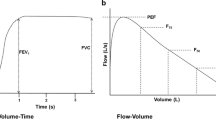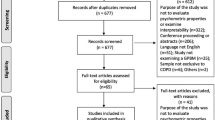Abstract
A wide range of outcome measures or endpoints has been used in clinical trials to assess the effects of treatments in paediatric respiratory diseases. This can make it difficult to compare treatment outcomes from different trials and also to understand whether new treatments offer a real clinical benefit for patients. Clinical trials in respiratory diseases evaluate three types of endpoints: subjective, objective and health-related outcomes. The ideal endpoint in a clinical trial needs to be accurate, precise and reliable. Ideally, the endpoint would also be measured with minimal risk and across all ages, easy to perform, and be inexpensive. As for any other disease, endpoints for respiratory diseases must be viewed in the context of the important distinction between clinical endpoints and surrogate endpoints. The association between surrogate endpoints and clinical endpoints must be clearly defined for any disease in order for them to be meaningful as outcome measures. The most common endpoints which are used in paediatric trials in respiratory diseases are discussed. For practical purposes, diseases have been separated into acute (bronchiolitis, acute viral-wheeze, acute asthma and croup) and chronic (asthma and cystic fibrosis). Further development of endpoints will enable clinical trials in children with respiratory diseases with the main objective of improving prognosis and safety.
Similar content being viewed by others
References
Bush A (2006) Evidence-based medicines for children: important implications for new therapies at all ages. Eur Respir J 28:1069–1072
Baiardi P, Ceci A, Felisi M, Cantarutti L, Girotto S, Sturkenboom M, Baraldi E (2010) In-label and off-label use of respiratory drugs in the Italian paediatric population. Acta Paediatr 99:544–549
Smyth AR, Barbato A, Beydon N, Bisgaard H, de Boeck K, Brand P et al (2010) Respiratory medicines for children: current evidence, unlicensed use and research priorities. Eur Respir J 35:247–265
Spahn J (2003) Clinical trial efficacy: what does it really tell you? J Allergy Clin Immunol 112:S102–S106
Biomarkers Definitions Working Group (2001) Biomarkers and surrogate endpoints: preferred definitions and conceptual framework. Clin Pharmacol Ther 69:89–95
Prentice RL (1989) Surrogate endpoints in clinical trials: definition and operational criteria. Stat Med 8:431–440
Smyth RL, Openshaw PJ (2006) Bronchiolitis. Lancet 368:312–322
Wainwright C, Altamirano L, Cheney M, Cheney J, Barber S, Price D et al (2003) A multicenter, randomized, double-blind, controlled trial of nebulized epinephrine in infants with acute bronchiolitis. N Engl J Med 349:27–35
Gajdos V, Beydon N, Bommenel L, Pellegrino B, de Pontual L, Bailleux S et al (2009) Inter-observer agreement between physicians, nurses, and respiratory therapists for respiratory clinical evaluation in bronchiolitis. Pediatr Pulmonol 44:754–762
Plint AC, Johnson DW, Patel H, Wiebe N, Correll R, Brant R et al (2009) Epinephrine and dexamethasone in children with bronchiolitis. N Engl J Med 360:2079–2089
Lenney W, Boner AL, Bont L, Bush A, Carlsen KH, Eber E et al (2009) Medicines for children used in respiratory diseases only seen in children. Eur Resp J 34:531–551
Panickar J, Lakhanpaul M, Lambert PC, Kenia P, Stephenson T, Smyth A, Grigg J (2009) Oral prednisolone for preschool children with acute virus-induced wheezing. N Engl J Med 360:329–338
Chalut DS, Ducharme FM, Davis GM (2000) The Preschool Respiratory Assessment Measure (PRAM): a responsive index of acute asthma severity. J Pediatr 137:762–768
Ducharme FM, Chalut D, Plotnick L, Savdie C, Kudirka D, Zhang X et al (2008) The Pediatric Respiratory Assessment Measure: a valid clinical score for assessing acute asthma severity from toddlers to teenagers. J Pediatr 152:476–480
Bacharier LB, Phillips BR, Zeiger RS, Szefler SJ, Martinez FD, Lemanske RF et al (2008) Episodic use of an inhaled corticosteroid or leukotriene receptor antagonist in preschool children with moderate-to-severe intermittent wheezing. J Allergy Clin Immunol 122:1127–1135
Indinnimeo L, Bertuola F, Cutrera R, de Benedictis FM, Di Pietro P, Duse M et al (2009) Clinical evaluation and treatment of acute asthma exacerbations in children. Int J Immunopathol Pharmacol 22:867–878
Ferguson C, Gidwani S (2006) Best evidence topic reports. Delivery of bronchodilators in acute asthma in children. Emerg Med J 23:471–472
Schuh S, Johnson DW, Stephens D, Callahan S, Winders P, Canny GJ (1999) Comparison of albuterol delivered by a metered dose inhaler with a spacer versus a nebulizer in children with mild acute asthma. J Pediatr 135:22–27
Cates CJ, Bara A, Crilly JA, Rowe BH (2003) Holding chambers versus nebulisers for beta-agonist treatment of acute asthma. Cochrane Database Syst Rev: CD000052. Update in: Cochrane Database Syst Rev 2006;(2):CD000052
Castro-Rodriguez JA, Rodrigo GJ (2004) Beta-agonists through metered-dose inhaler with valved holding chamber versus nebulizer for acute exacerbations of wheezing or asthma in children under 5 years of age; a systematic review with metanalysis. J Pediatr 145:172–177
Deerojanawong J, Manuyakorn W, Prapphal N, Harnruthakorn C, Sritippayawan S, Samransamruajkit R (2005) Randomized controlled trial of salbutamol aerosol therapy via metered dose inhaler-spacer vs. jet nebulizer in young children with wheezing. Pediatr Pulmonol 39:466–472
Cherry JD (2008) Croup. N Engl J Med 358:384–391
Bjornson CL, Johnson DW (2008) Croup. Lancet 371:329–339
Reddel HK, Taylor DR, Bateman ED, Boulet LP, Boushey HA, Busse WW et al (2009) American Thoracic Society/European Respiratory Society Task Force on Asthma Control and Exacerbations. An official American Thoracic Society/European Respiratory Society statement: asthma control and exacerbations: standardizing endpoints for clinical asthma trials and clinical practice. Am J Respir Crit Care Med 180:59–99
Pauwels RA, Lofdahl C-G, Postma DS, Tattersfield AE, O’Byrne P, Barnes PJ, Ullman A (1997) Effect of inhaled formoterol and budesonide on exacerbations of asthma. N Engl J Med 337:1405–1411
Kerstjens HAM, Brand PLP, Jong PMD, Koeter GH, Postma DS, Dutch CNSLD Study Group (1994) Influence of treatment on peak expiratory flow and its relation to airway hyperresponsiveness and symptoms. Thorax 49:1109–1115
Juniper EF, O’Byrne PM, Guyatt GH, Ferrie PJ, King DR (1999) Development and validation of a questionnaire to measure asthma control. Eur Respir J 14:902–907
Cockcroft DW, Swystun VA (1996) Asthma control versus asthma severity. J Allergy Clin Immunol 98:1016–1018
Nathan RA, Sorkness CA, Kosinski M, Schatz M, Li JT, Marcus P et al (2004) Development of the asthma control test: a survey for assessing asthma control. J Allergy Clin Immunol 113:59–65
Scichilone N, Deykin A, Pizzichini E, Bellia V, Polosa R (2004) Monitoring response to treatment in asthma management: food for thought. Clin Exp Allergy 34:1168–1177
Covar RA, Spahn JD, Martin RJ, Silkoff PE, Sundstrom DA, Murphy J, Szefler SJ (2004) Safety and application of induced sputum analysis in childhood asthma. J Allergy Clin Immunol 114:575–582
American Thoracic Society, European Respiratory Society (2005) ATS/ERS recommendations for standardized procedures for the online and offline measurement of exhaled lower respiratory nitric oxide and nasal nitric oxide, 2005. Am J Respir Crit Care Med 171:912–930
Horvath I, Hunt J, Barnes PJ, Alving K, Antczak A, Baraldi E et al (2005) Exhaled breath condensate: methodological recommendations and unresolved questions. Eur Respir J 26:523–548
Venge P, Bystrom J, Carlson M, Hakansson L, Karawacjzyk M, Peterson C et al (1999) Eosinophil cationic protein (ECP): molecular and biological properties and the use of ECP as a marker of eosinophil activation in disease. Clin Exp Allergy 29:1172–1186
Erickson SR, Kirking DM (2004) Variation in the distribution of patient reported outcomes based on different definitions of defining asthma severity. Curr Med Res Opin 20:1863–1872
Rowe SM, Miller S, Sorscher EJ (2005) Cystic fibrosis. N Engl J Med 352:1992–2001
O'Sullivan BP, Freedman SD (2009) Cystic fibrosis. Lancet 373:1891–1904
Elkins MR, Robinson M, Rose BR, Harbour C, Moriarty CP, Marks GB et al (2006) A controlled trial of long-term inhaled hypertonic saline in patients with cystic fibrosis. N Engl J Med 354:229–240
Rosenfeld M (2007) An overview of endpoints for cystic fibrosis clinical trials: one size does not fit all. Proc Am Thor Soc 4:299–301
Quittner AL, Sweeny S, Watrous M, Munzenberger P, Bearss K, Gibson Nitza A et al (2000) Translation and linguistic validation of a disease-specific quality of life measure for cystic fibrosis. J Pediatr Psychol 25:403–414
Davis SD, Brody AS, Emond MJ, Brumback LC, Rosenfeld M (2007) Endpoints for clinical trials in young children with cystic fibrosis. Proc Am Thorac Soc 4:418–430
Author information
Authors and Affiliations
Consortia
Corresponding author
Additional information
Part of the TEDDY supplement
Rights and permissions
About this article
Cite this article
de Benedictis, F.M., Guidi, R., Carraro, S. et al. Endpoints in respiratory diseases. Eur J Clin Pharmacol 67 (Suppl 1), 49–59 (2011). https://doi.org/10.1007/s00228-010-0922-2
Received:
Accepted:
Published:
Issue Date:
DOI: https://doi.org/10.1007/s00228-010-0922-2




